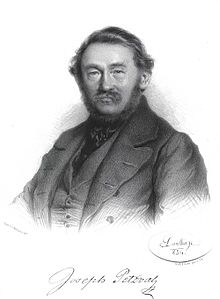Josef Maximilian Petzval


Jozef Maximilián Petzval (born January 6, 1807 Spišská Belá (German Zipser Bela, Hungarian Szepesbéla), † September 17, 1891 in Vienna ), also known by his German name Joseph Maximilian Petzval or the Hungarian name Petzval József Miksa , was a Hungarian German Mathematician.
Life
Petzval later studied and taught at the University of Pest (part of what later became Budapest ). In 1837 he accepted a chair for mathematics at the University of Vienna . He was a member of the Hungarian Academy of Sciences (MTA).
Petzval's most famous achievement is Petzval's portrait lens , which after 150 years still has some meaning. He did fundamental work on the theory of aberrations in optical systems. Some central terms in this field were later named after him:
- The Petzval surface is the generally curved image surface of an uncorrected optical system, a paraboloid of revolution .
- If the Petzval condition is observed, the Petzval surface is flat.
The powerful Orthoskop landscape lens also goes back to Petzval's developments .
The Petzval Glacier in Antarctica is also named after him.
In mathematics, he worked on applications of the Laplace transformation, among other things .
Fonts
- Report on the results of some dioptric examinations (Pest, 1843)
- Integration of the linear differential equations (I.-II., Vienna, 1853-59)
- Report on optical and dioptric examinations (meeting reports, Vienna, 1857)
literature
- Manuela Fellner, Anton Holzer, Elisabeth Limbeck (eds.): The sharpening of the view: Joseph Petzval: the light, the city and the photography . Exhibition catalog Technisches Museum Wien, 2003, ISBN 3-902183-07-1 .
- Cornelia Kemp: Petzval, Josef Max. In: New German Biography (NDB). Volume 20, Duncker & Humblot, Berlin 2001, ISBN 3-428-00201-6 , pp. 277 f. ( Digitized version ).
- A. Durstmüller: Petzval Josef Maximilian. In: Austrian Biographical Lexicon 1815–1950 (ÖBL). Volume 8, Verlag der Österreichischen Akademie der Wissenschaften, Vienna 1983, ISBN 3-7001-0187-2 , p. 17 f. (Direct links on p. 17 , p. 18 ).
- https://www.academia.edu/6313483/Josef_Petzval_1807-1891_and_the_early_development_of_astrophotography
- oN: Photographic relics . In: Richard Neuhauss (ed.): Photographische Rundschau , 9th year, Wilhelm Georg Knapp , Halle / S., 1895, p. 47ff., Comments on the article: p. 91ff.
- Dr. Josef Petzval (obituary notice with a short biography). In: Photographische Rundschau . 5th year, 1891, Knapp, Halle / S., P. 347.
Web links
| personal data | |
|---|---|
| SURNAME | Petzval, Josef Maximilian |
| ALTERNATIVE NAMES | Petzval, Jozef Maximilián; Petzvál, Joseph Maximilian; Petzval József Miksa |
| BRIEF DESCRIPTION | Slovak mathematician |
| DATE OF BIRTH | January 6, 1807 |
| PLACE OF BIRTH | Spišská Belá |
| DATE OF DEATH | September 17, 1891 |
| Place of death | Vienna |